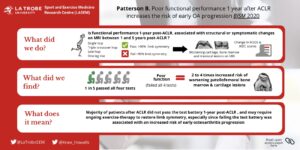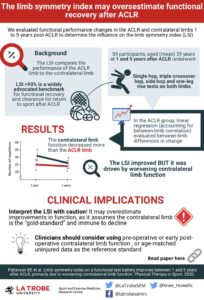Live Q & A with Dr Adam Culvenor and Brooke Patterson
Weren’t able to make it to the live event? We’ve got you covered!
Hear Dr Culvenor speak about the prevalence of MRI features in people without knee symptoms, what ‘good’ looks like in terms of patient outcomes following ACL injury, and whether or not surgery is required for everyone who has an ACL injury.
This event was hosted by Dr. Sean Docking, with special guest PhD Candidate Brooke Patterson.
To stay up-to-date with the latest research at the centre, keep an eye on our blog and on our Twitter account @LaTrobeSEM
Link to Poor Functional Performance Infographic:
Link to Limb Symmetry Index Infographic:
References/links as they appear in the webinar:
- Prevalence of knee osteoarthritis features on magnetic resonance imaging.
Culvenor AG, Øiestad BE, Hart HF, et al. Prevalence of knee osteoarthritis features on magnetic resonance imaging in asymptomatic uninjured adults: a systematic review and meta-analysis. British Journal of Sports Medicine 2019;53:1268-1278.
https://bjsm.bmj.com/content/53/20/1268
2. Decreased loading of the ACL Injured Knee
Sritharan, P., Schache, A. G., Culvenor, A. G., Perraton, L. G., Bryant, A. L., & Crossley, K. M. (2020). Between-limb differences in patellofemoral joint forces during running at 12 to 24 months after unilateral anterior cruciate ligament reconstruction. American Journal of Sports Medicine, 48(7), 1711-1719. doi:10.1177/0363546520914628
https://journals.sagepub.com/doi/abs/10.1177/0363546520914628
3. Worsening Knee OA features on magnetic resonance imaging 1 to 5 years after ACLR
Patterson, B. E., Culvenor, A. G., Barton, C. J., Guermazi, A., Stefanik, J. J., Morris, H. G., . . . Crossley, K. M. (2018). Worsening knee osteoarthritis features on magnetic resonance imaging 1 to 5 years after anterior cruciate ligament reconstruction. American Journal of Sports Medicine, 46(12), 2873-2883. doi:10.1177/0363546518789685
https://pubmed.ncbi.nlm.nih.gov/30179520/
4. Patient Reported Outcome Measures + MRI features
Patterson, B. E., Culvenor, A. G., Barton, C. J., Guermazi, A., Stefanik, J. J., & Crossley, K. M. (2020). Patient-reported outcomes one to five years after anterior cruciate ligament reconstruction: The effect of combined injury and associations with osteoarthritis features defined on magnetic resonance imaging. Arthritis Care and Research, 72(3), 412-422. doi:10.1002/acr.23854
https://onlinelibrary.wiley.com/doi/abs/10.1002/acr.23854
5. Poor Functional Performance 1 year after ACLR increases the risk of early OA progression
Patterson, B., Culvenor, A. G., Barton, C. J., Guermazi, A., Stefanik, J., Morris, H. G., . . . Crossley, K. M. (2020). Poor functional performance 1 year after ACL reconstruction increases the risk of early osteoarthritis progression. British Journal of Sports Medicine, 54(9), 246-253. doi:10.1136/bjsports-2019-101503
https://bjsm.bmj.com/content/54/9/546
6. Limb Symmetry Index
Patterson, B. E., Crossley, K. M., Perraton, L. G., Kumar, A. S., King, M. G., Heerey, J. J., . . . Culvenor, A. G. (2020). Limb symmetry index on a functional test battery improves between one and five years after anterior cruciate ligament reconstruction, primarily due to worsening contralateral limb function. Physical Therapy in Sport, 44, 67-74. doi:10.1016/j.ptsp.2020.04.031
https://www.sciencedirect.com/science/article/abs/pii/S1466853X20300055
7. Pediatric ACL population
Moksnes H, Engebretsen L, Eitzen I, Risberg MA. Functional outcomes following a non-operative treatment algorithm for anterior cruciate ligament injuries in skeletally immature children 12 years and younger. A prospective cohort with 2 years follow-up. Br J Sports Med. 2013;47(8):488-494. doi:10.1136/bjsports-2012-092066
https://pubmed.ncbi.nlm.nih.gov/23446640/
8. Treatment of Acute ACL Tears – Optimal management?
Frobell RB, Roos EM, Roos HP, Ranstam J, Lohmander LS. A randomized trial of treatment for acute anterior cruciate ligament tears [published correction appears in N Engl J Med. 2010 Aug 26;363(9):893]. N Engl J Med. 2010;363(4):331-342. doi:10.1056/NEJMoa0907797
https://pubmed.ncbi.nlm.nih.gov/20660401/
9. Increased Cartilage Thining in those who opt for early reconstruction.
Culvenor AG, Eckstein F, Wirth W, et al (2019) Loss of patellofemoral cartilage thickness over 5 years following ACL injury depends on the initial treatment strategy: results from the KANON trial. British Journal of Sports Medicine;53:1168-1173.
https://bjsm.bmj.com/content/53/18/1168
10. Consensus criteria for defining ‘successful’ outcome after ACL injury
Lynch AD, Logerstedt DS, Grindem H, et al (2015). Consensus criteria for defining ‘successful outcome’ after ACL injury and reconstruction: a Delaware-Oslo ACL cohort investigation. British Journal of Sports Medicine;49:335-342.
https://bjsm.bmj.com/content/49/5/335
11. Making football safer for women
Crossley KM, Patterson BE, Culvenor AG, et al (2020). Making football safer for women: a systematic review and meta-analysis of injury prevention programmes in 11 773 female football (soccer) players. British Journal of Sports Medicine Published Online. doi: 10.1136/bjsports-2019-101587
https://bjsm.bmj.com/content/early/2020/04/16/bjsports-2019-101587
12. Psychological readiness to return to sport
Hart, H. F., Culvenor, A. G., Guermazi, A., & Crossley, K. M. (2020). Worse knee confidence, fear of movement, psychological readiness to return-to-sport and pain are associated with worse function after ACL reconstruction. Physical Therapy in Sport, 41, 1-8. doi:10.1016/j.ptsp.2019.10.006



